Mercury Villager 2001 Owner's Manuals
Manufacturer: MERCURY, Model Year: 2001, Model line: Villager, Model: Mercury Villager 2001Pages: 256, PDF Size: 2.35 MB
Page 141 of 256

7. Pull the lap belt portion across
the child seat toward the buckle and
pull up on the shoulder belt while
pushing down with your knee on the
child seat.
8. Allow the safety belt to retract to
remove any slack in the belt.
9. Before placing the child in the
seat, forcibly tilt the seat forward
and back to make sure the seat is
securely held in place.
10. Try to pull the belt out of the retractor to make sure the retractor is
in the automatic locking mode (you should not be able to pull more belt
out). If the retractor is not locked, unbuckle the belt and repeat steps
two through nine.
Check to make sure the child seat is properly secured before each use.
Installing child safety seats in the lap belt seating positions
1. Lengthen the lap belt. To lengthen the belt, hold the tongue so that its
bottom is perpendicular to the direction of webbing while sliding the
tongue up the webbing.
2. Place the child safety seat in the center seating position.
3. Route the tongue and webbing through the child seat according to the
child seat manufacturer's instructions.
4. Insert the belt tongue into the proper buckle for the center seating
position until you hear a snap and feel it latch. Make sure the tongue is
securely fastened to the buckle by pulling on tongue.
Seating and safety restraints
141
Page 142 of 256

5. Push down on the child seat while pulling on the loose end of the lap
belt webbing to tighten the belt.
6. Before placing the child into the child seat, forcibly tilt the child seat
from side to side and in forward direction to make sure that the seat is
held securely in place. If the child seat moves excessively, repeat steps 5
through 6, or properly install the child seat in a different position.
Attaching safety seats with tether straps
Most new forward-facing child safety seats include a tether strap that
goes over the back of the vehicle seat and hooks to an anchoring point.
Tether straps are available as an accessory for many older safety seats.
Contact the manufacturer of your child safety seat for information about
ordering a tether strap.
Children should be placed in the rear in an appropriate child
safety seat that is properly secured to the vehicle.
Most new forward-facing child safety seats include a tether strap which
goes over the back of the seat and hooks to an anchoring point. Tether
straps are available as an accessory for many older safety seats. Contact
the manufacturer of your child seat for information about ordering a
tether strap.
Tether strap anchors have been
provided in your vehicle. The left
side of the figure is the front of the
vehicle.
Seating and safety restraints
142
Page 143 of 256
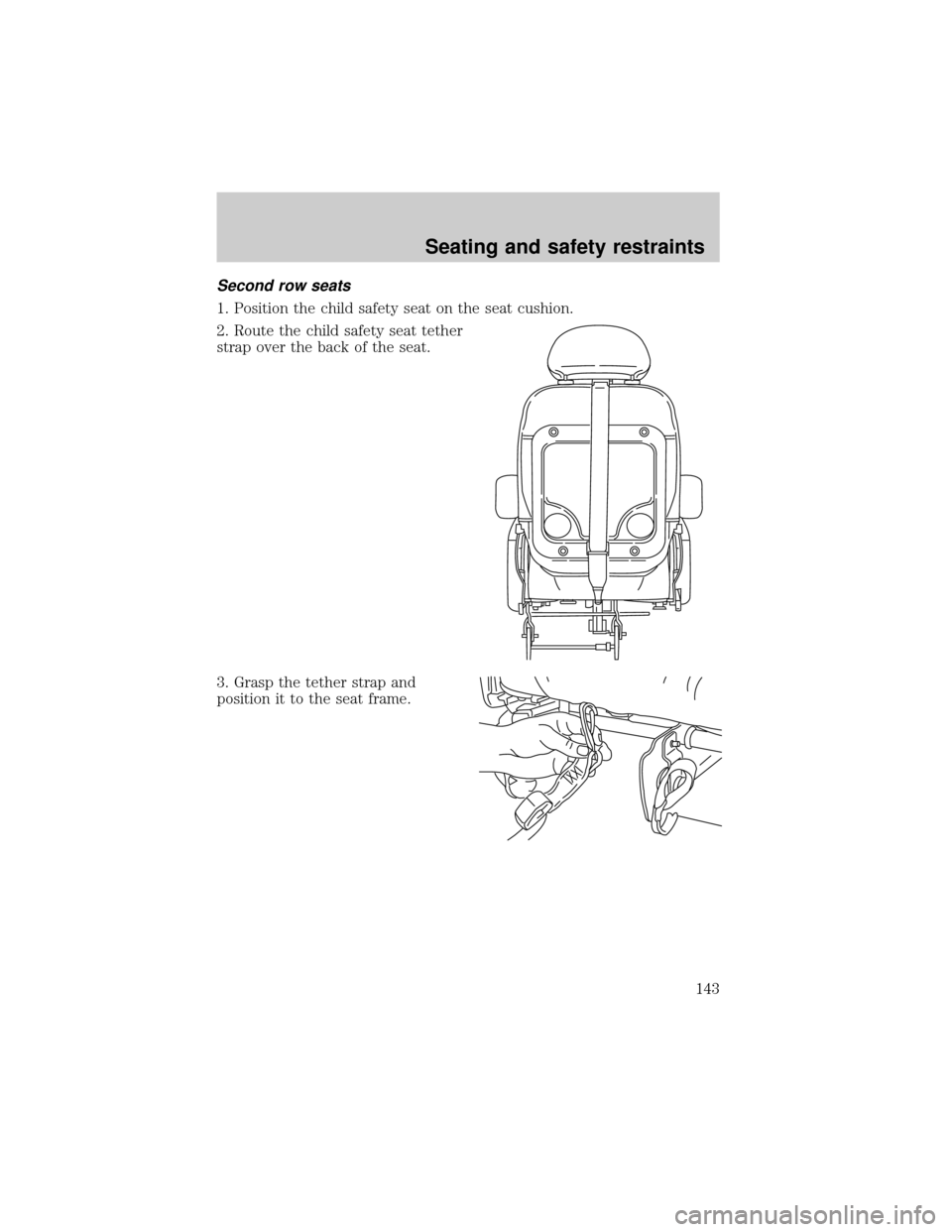
Second row seats
1. Position the child safety seat on the seat cushion.
2. Route the child safety seat tether
strap over the back of the seat.
3. Grasp the tether strap and
position it to the seat frame.
Seating and safety restraints
143
Page 144 of 256
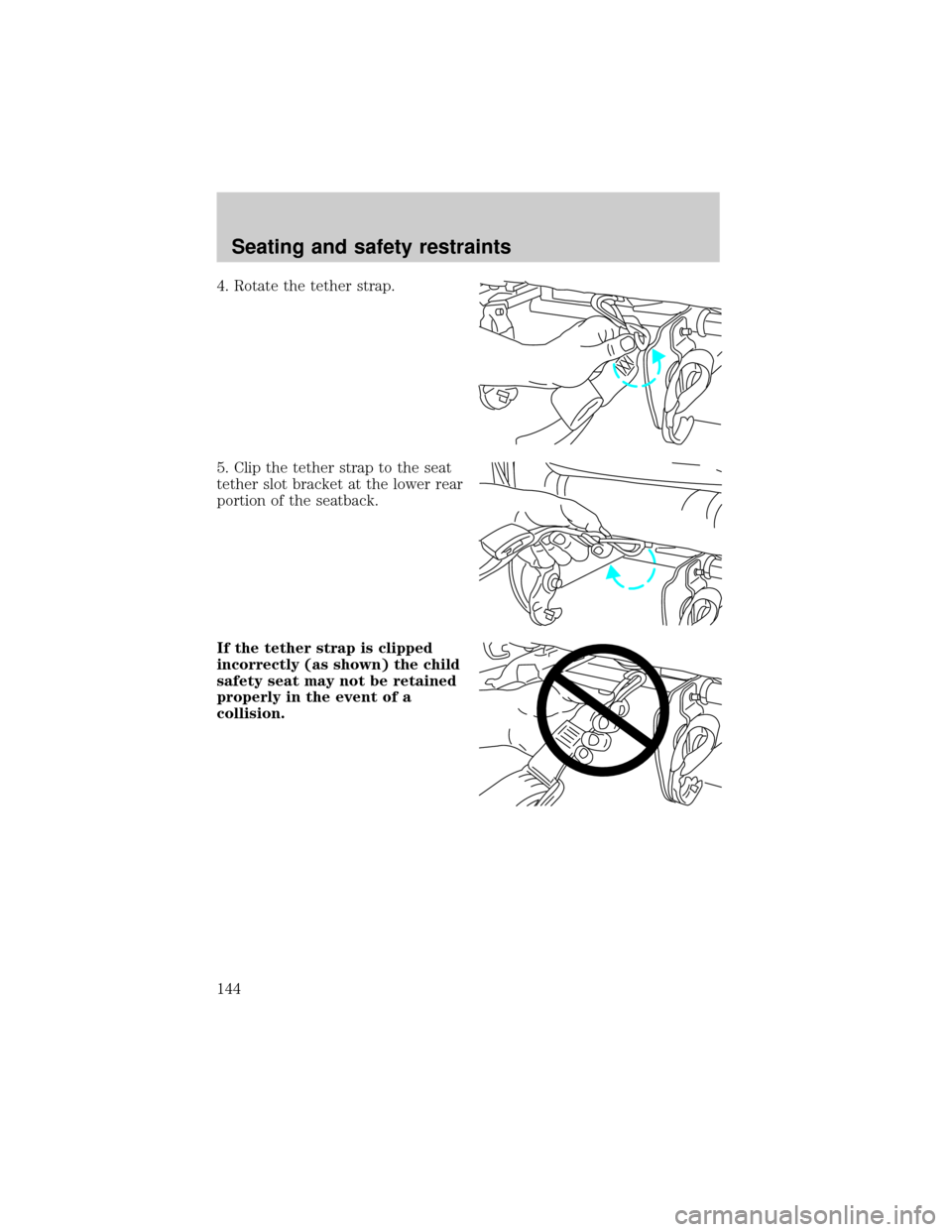
4. Rotate the tether strap.
5. Clip the tether strap to the seat
tether slot bracket at the lower rear
portion of the seatback.
If the tether strap is clipped
incorrectly (as shown) the child
safety seat may not be retained
properly in the event of a
collision.
Seating and safety restraints
144
Page 145 of 256

6. Rotate the tether strap clip.
7. Refer to the instructions in this
section underInstalling child
safety seats in combination lap
and shoulder belt seating
positionsto secure the child safety
seat.
8. Tighten the child safety seat
tether strap according to the
manufacturer's instructions.
Third row seats
The third row seat child tether anchors are located on the bottom back
side of the seat. Refer toSecond row seatslisted previously for
installation instructions.
Seating and safety restraints
145
Page 146 of 256
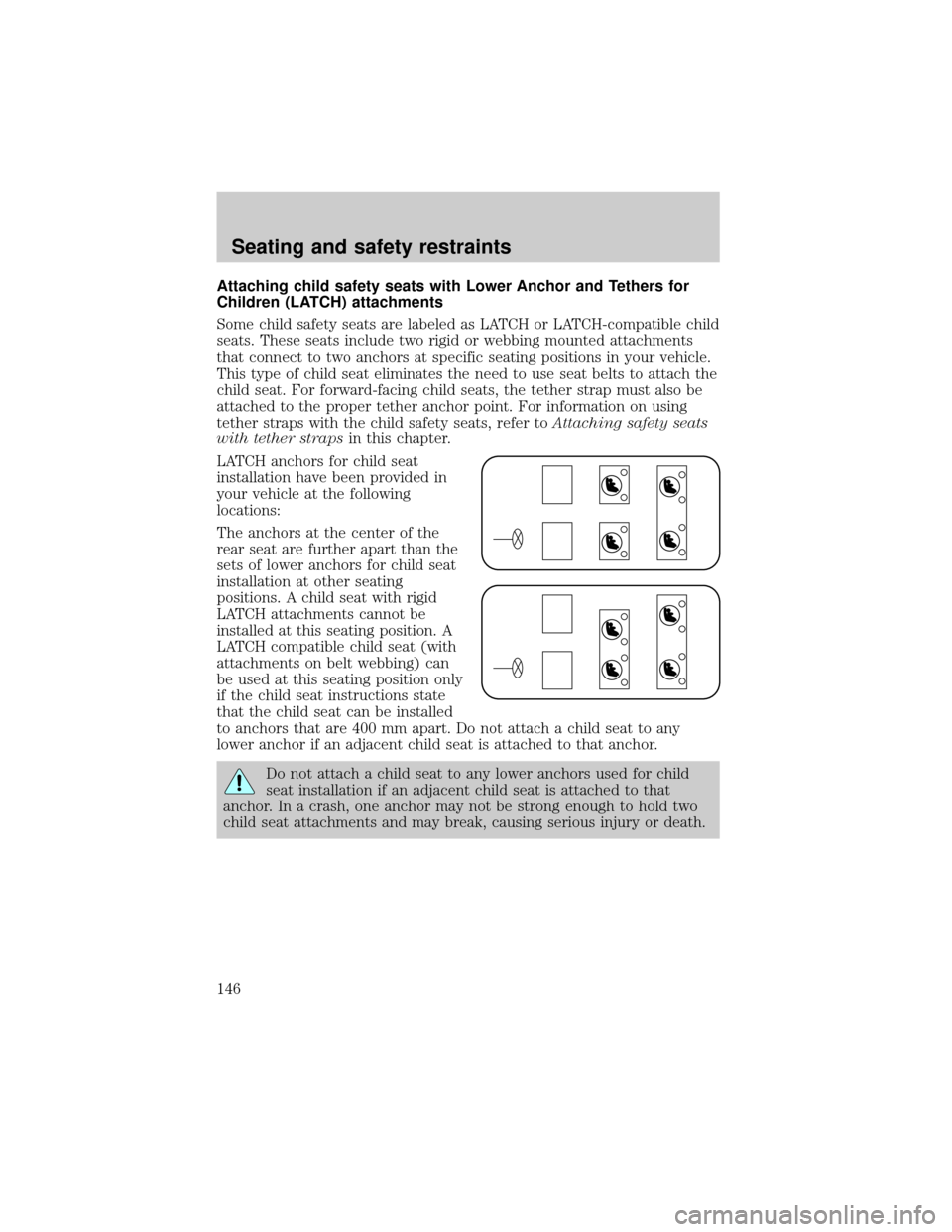
Attaching child safety seats with Lower Anchor and Tethers for
Children (LATCH) attachments
Some child safety seats are labeled as LATCH or LATCH-compatible child
seats. These seats include two rigid or webbing mounted attachments
that connect to two anchors at specific seating positions in your vehicle.
This type of child seat eliminates the need to use seat belts to attach the
child seat. For forward-facing child seats, the tether strap must also be
attached to the proper tether anchor point. For information on using
tether straps with the child safety seats, refer toAttaching safety seats
with tether strapsin this chapter.
LATCH anchors for child seat
installation have been provided in
your vehicle at the following
locations:
The anchors at the center of the
rear seat are further apart than the
sets of lower anchors for child seat
installation at other seating
positions. A child seat with rigid
LATCH attachments cannot be
installed at this seating position. A
LATCH compatible child seat (with
attachments on belt webbing) can
be used at this seating position only
if the child seat instructions state
that the child seat can be installed
to anchors that are 400 mm apart. Do not attach a child seat to any
lower anchor if an adjacent child seat is attached to that anchor.
Do not attach a child seat to any lower anchors used for child
seat installation if an adjacent child seat is attached to that
anchor. In a crash, one anchor may not be strong enough to hold two
child seat attachments and may break, causing serious injury or death.
Seating and safety restraints
146
Page 147 of 256
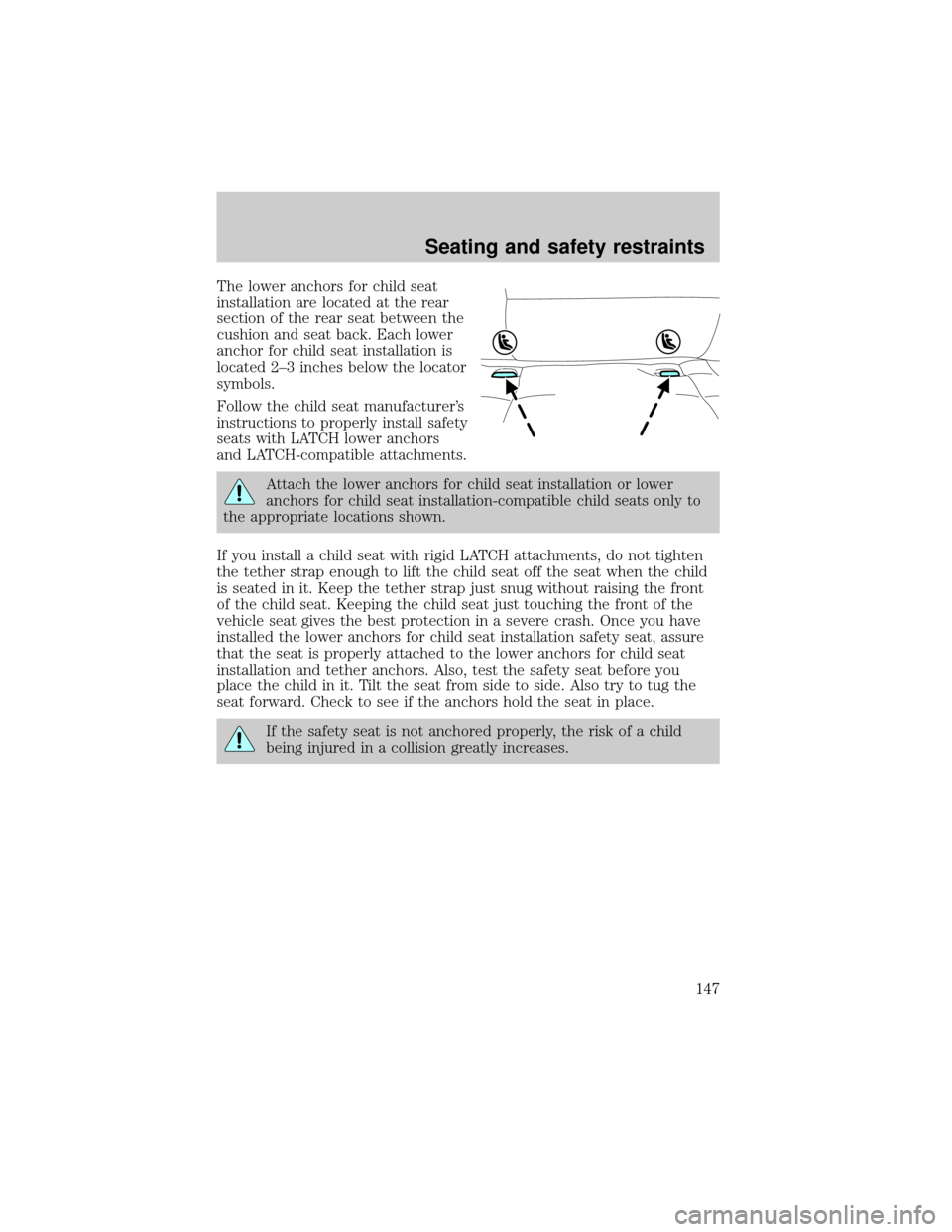
The lower anchors for child seat
installation are located at the rear
section of the rear seat between the
cushion and seat back. Each lower
anchor for child seat installation is
located 2±3 inches below the locator
symbols.
Follow the child seat manufacturer's
instructions to properly install safety
seats with LATCH lower anchors
and LATCH-compatible attachments.
Attach the lower anchors for child seat installation or lower
anchors for child seat installation-compatible child seats only to
the appropriate locations shown.
If you install a child seat with rigid LATCH attachments, do not tighten
the tether strap enough to lift the child seat off the seat when the child
is seated in it. Keep the tether strap just snug without raising the front
of the child seat. Keeping the child seat just touching the front of the
vehicle seat gives the best protection in a severe crash. Once you have
installed the lower anchors for child seat installation safety seat, assure
that the seat is properly attached to the lower anchors for child seat
installation and tether anchors. Also, test the safety seat before you
place the child in it. Tilt the seat from side to side. Also try to tug the
seat forward. Check to see if the anchors hold the seat in place.
If the safety seat is not anchored properly, the risk of a child
being injured in a collision greatly increases.
Seating and safety restraints
147
Page 148 of 256

PREPARING TO START YOUR VEHICLE
Engine starting is controlled by the powertrain control system. This
system meets all Canadian Interference-Causing Equipment standard
requirements regulating the impulse electrical field strength of radio noise.
When starting a fuel-injected engine, avoid pressing the accelerator
before or during starting. Only use the accelerator when you have
difficulty starting the engine. For more information on starting the
vehicle, refer toStarting the enginein this chapter.
Extended idling at high engine speeds can produce very high
temperatures in the engine and exhaust system, creating the risk
of fire or other damage.
Do not park, idle, or drive your vehicle in dry grass or other dry
ground cover. The emission system heats up the engine
compartment and exhaust system, which can start a fire.
Do not start your vehicle in a closed garage or in other enclosed
areas. Exhaust fumes can be toxic. Always open the garage door
before you start the engine. SeeGuarding against exhaust fumesin
this chapter for more instructions.
If you smell exhaust fumes inside your vehicle, have your dealer
inspect your vehicle immediately. Do not drive if you smell
exhaust fumes.
Important safety precautions
A computer system controls the engine's idle revolutions per minute
(RPM). When the engine starts, the idle RPM runs faster to warm the
engine. If the engine idle speed does not slow down automatically, have
the vehicle checked. Do not allow the vehicle to idle for more than 10
minutes at the higher engine RPM.
Before starting the vehicle:
1. Make sure all vehicle occupants have buckled their safety belts. For
more information on safety belts and their proper usage, refer to the
Seating and safety restraintschapter.
2. Make sure the headlamps and vehicle accessories are off.
Starting
148
Page 149 of 256
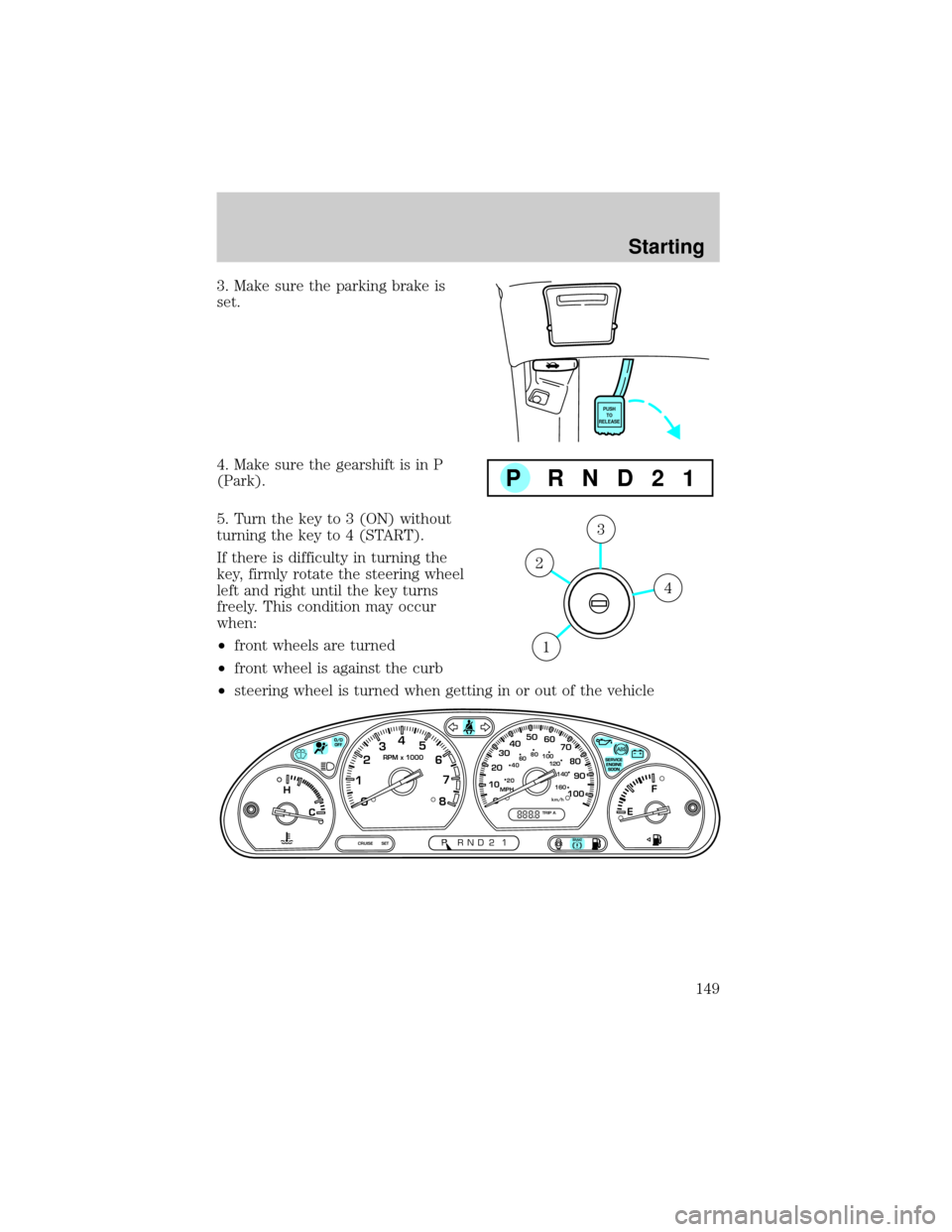
3. Make sure the parking brake is
set.
4. Make sure the gearshift is in P
(Park).
5. Turn the key to 3 (ON) without
turning the key to 4 (START).
If there is difficulty in turning the
key, firmly rotate the steering wheel
left and right until the key turns
freely. This condition may occur
when:
²front wheels are turned
²front wheel is against the curb
²steering wheel is turned when getting in or out of the vehicle
PUSH
TO
RELEASE
P RND21
4
3
2
1
km/h0 1020304050
60
70
80
90
100MPH
TRIP A
RPM x 1000
20406080
100
120
140
160
0 1234
5
6
7
8F
H
CE
CRUISE SETPRND2P1
Starting
149
Page 150 of 256

Make sure the corresponding lights illuminate or illuminate briefly. If a
light fails to illuminate, have the vehicle serviced.
²If the driver's safety belt is fastened, the
light may not illuminate.
STARTING THE ENGINE
NOTE:Whenever you start your vehicle, release the key as soon as the
engine starts. Excessive cranking could damage the starter.
1.
Turn the key to 4 (START) without
pressing the accelerator pedal and
release as soon as the engine starts.
The key will return to 3 (ON).
2. If the temperature is above ±12ÉC
(10ÉF) and the engine does not
start within five seconds on the first
try, turn the key to OFF, wait 10
seconds and try again.
3. If the temperature is below -12É C (10É F) and the engine does not
start in 15 seconds on the first try, turn the key OFF and wait 10
seconds and try again. If the engine does not start in two attempts, Press
the accelerator pedal all the way to floor and hold. Turn the key to
START position.
4. When the engine starts, release the key, then release the accelerator
pedal gradually as the engine speeds up.
5. After idling for a few seconds, apply the brake and release the parking
brake.
Using the engine block heater (if equipped)
An engine block heater warms the engine coolant, which improves
starting, warms up the engine faster and allows the heater-defroster
SERVICE
ENGINE
SOONABSAIR
BAGABSO/D
OFF
OUTSIDE TEMP
INST ECONOMY
AVG. ECONOMY
TO EMPTY
PRND21FUEL DOOR UNLEADED FUEL ONLY CRUISE
MPH
km/h
km
F
EH
C
1/2N
O
R
M
A
L
012345
6
78
P!BRAKE
X 1000
RPMTRIP 1
TRIP 2 ˚F ˚C
MILES/BAL
L/100 km
4
3
2
1
Starting
150